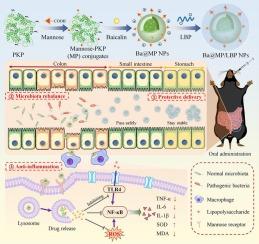甘露糖修饰的桃核蛋白纳米颗粒载黄芩苷包被枸杞多糖治疗溃疡性结肠炎
IF 12.5
1区 化学
Q1 CHEMISTRY, APPLIED
引用次数: 0
摘要
黄芩苷(Baicalin, Ba)是治疗溃疡性结肠炎(UC)的一种很有前途的抗炎药,但其溶解度和结肠靶向性差限制了其疗效。枸杞多糖(Lycium barbarum多糖,LBP)是一种阴离子多糖,不仅能修复肠道菌群失调,还具有良好的上胃肠道稳定性和生物相容性,是开发结肠靶向载体的候选物质。本文以枸杞多糖、甘露糖和桃核蛋白(PKP)为原料,构建了靶向递送黄芩苷的聚合纳米颗粒(Ba@MP/LBP NPs),以提高黄芩苷治疗UC的疗效。所得Ba@MP/LBP NPs具有核壳球形形貌、窄粒径分布(~ 230 nm)、负表面电荷(- 33.89 mV)和良好的黄芩苷包封率(94.26%)。在LBP包被的帮助下,Ba@MP/LBP NPs可以耐受上消化道紊乱,并将Ba@MP NPs转运到结肠,从而通过甘露糖受体介导的内吞作用促进炎性巨噬细胞摄取黄芩苷。此外,LBP包被增强了Ba@MP NPs调节肠道菌群的能力;因此,Ba@MP/LBP NPs可以恢复肠道菌群平衡,同时抑制促炎因子分泌和氧化应激,最终缓解UC。更重要的是,Ba@MP/LBP NPs具有良好的生物安全性。总的来说,这项工作是首次尝试将LBP和PKP作为结肠靶向载体,为UC治疗提供了一种有前景的纳米药物。本文章由计算机程序翻译,如有差异,请以英文原文为准。

Mannose-modified Prunus persica kernel protein nanoparticles loading baicalin coated with Lycium barbarum polysaccharide for ulcerative colitis treatment
Baicalin (Ba) is a promising anti-inflammatory agent for treating ulcerative colitis (UC), but its efficacy is constrained by poor solubility and colon-targeting efficiency. Lycium barbarum polysaccharide (LBP), an anionic polysaccharide, not only restores gut microbiota dysbiosis but also exhibits excellent upper gastrointestinal stability and biocompatibility, making it a candidate for developing colon-targeted carriers. In this paper, the polymeric nanoparticles (Ba@MP/LBP NPs) were constructed using LBP, mannose, and Prunus persica kernel protein (PKP) for targeted delivery of baicalin to enhance its efficacy in UC treatment. The obtained Ba@MP/LBP NPs possessed core-shell spherical morphology, narrow particle-size distribution (∼230 nm), negative surface charge (−33.89 mV), and excellent baicalin encapsulation (94.26 %). With the aid of the LBP coating, Ba@MP/LBP NPs can tolerate upper gastrointestinal disturbances and transport Ba@MP NPs into colon, thereby facilitating baicalin uptake by inflammatory macrophages via mannose receptor-mediated endocytosis. Furthermore, the LBP coating strengthened Ba@MP NPs' ability to regulate the intestinal flora; hence, Ba@MP/LBP NPs can restore gut microbiota balance while suppressing pro-inflammatory factor secretion and oxidative stress, ultimately alleviating UC. More importantly, Ba@MP/LBP NPs exhibited favorable biosafety. Overall, this work is the first attempt to employ LBP and PKP as colon-targeting carriers, providing a promising nanomedicine for UC therapy.
求助全文
通过发布文献求助,成功后即可免费获取论文全文。
去求助
来源期刊

Carbohydrate Polymers
化学-高分子科学
CiteScore
22.40
自引率
8.00%
发文量
1286
审稿时长
47 days
期刊介绍:
Carbohydrate Polymers stands as a prominent journal in the glycoscience field, dedicated to exploring and harnessing the potential of polysaccharides with applications spanning bioenergy, bioplastics, biomaterials, biorefining, chemistry, drug delivery, food, health, nanotechnology, packaging, paper, pharmaceuticals, medicine, oil recovery, textiles, tissue engineering, wood, and various aspects of glycoscience.
The journal emphasizes the central role of well-characterized carbohydrate polymers, highlighting their significance as the primary focus rather than a peripheral topic. Each paper must prominently feature at least one named carbohydrate polymer, evident in both citation and title, with a commitment to innovative research that advances scientific knowledge.
 求助内容:
求助内容: 应助结果提醒方式:
应助结果提醒方式:


